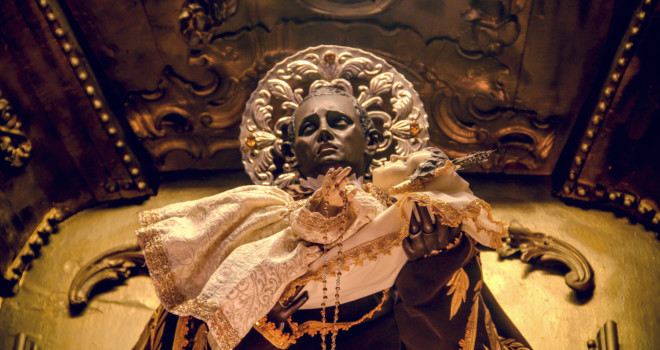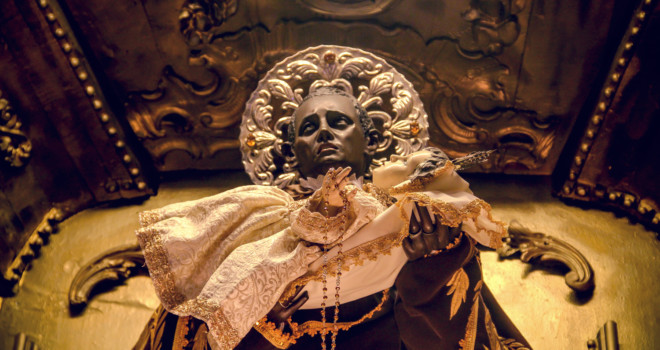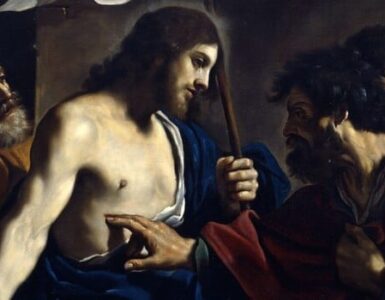The three theological virtues God infuses into our hearts and souls are, of course, faith, hope, and charity. There is no question that St. Martin de Porres had a deep Catholic faith and a persevering hope in attaining salvation through God’s aid. But the greatest of these God-given theological virtues is charity, or love, and it is here that we truly see Saint Martin in his greatest splendor. In my mind, he was a thinker and a doer indeed, but a lover par excellence.
St. Thomas compared love to a furnace, and the more powerful the furnace, the farther will it warm with its heat. Martin strove to bring that love to the ends of the world. Indeed, stories were told that God had given him the gift of bilocation, and he had mystically traveled to those places, as well as Africa and France. Some people who came to Lima said they spoke to him in those lands. Of this we can be sure: the furnace of Saint Martin’s love reached around the world.
A Love for Creatures
Indeed, the furnace of Saint Martin’s love warmed not only men and women, but all sorts of animals too! There are numerous stories of Saint Martin’s interventions, healing and feeding dogs, cats, mice, mules, cattle, chickens, et cetera. In one endearing story, he had a dog, a cat, and a mouse eating peacefully out of the same bowl. Although some people have considered this entertaining fair for the amusement and edification of children, some scholars have noted deeper levels of cultural and theological significance in these very numerous “little stories” people have told about Saint Martin. Some have noted, for example, that this story of the harmonious dog, cat, and mouse represents the harmony he sought to establish between the races of Peru.

Another story relates that Martin would arise before 4:30 each morning to fulfill his duties as his priory’s campanero, that is, bell-ringer. Well, early in the morning, a cat would work its way into Martin’s cell and pull on his habit until Martin woke up. The most interesting tidbit is in the details, since the cat was said to be white, black, and brown, a mestizo, like Martin himself. Does this story not convey a powerful message about the man who would ring the bell to draw the white, black, and brown together to sing harmonious praises to their common Father?
Martin brought people together in his time and does so even in ours, and that phenomenon was seen clearly at his canonization proceedings. Thousands of people from dozens of nations gathered together at the Vatican on May 6, 1962, including 3,000 from Spain, 1,000 from Peru, 350 African-Americans (and half of them Protestant!), and 1,500 from Ireland, and that Irish contingent brings an illuminating parallel to mind.
St. Brigid & St. Martin
My first exemplar in writing of a loving saint of “the charitable style” was Saint Brigid of Ireland. She, like Saint Martin, was and still is well known and loved for her compassion and acts of mercy for the sick and the poor, along with unmatched sweetness, kindness, and liberal hospitality. And here is the fascinating parallel. A legend relates that it was prophesied that Saint Brigid would be born neither outside nor inside and that she would bring great good to the world. As the story goes, she was born while her mother, carrying a pail of milk, was crossing the threshold into her house, neither completely outside nor inside!
But could this amusing Irish “little story” have a deeper significance with a lesson much like that of the life of Saint Martin de Porres? Well, Saint Brigid’s father was a powerful Irish chieftain, and her mother was his unmarried slave.
Some argue, with good reason, that part of Saint Brigid’s success was due to the fact that she could relate to those of both worlds, both the rich and the poor, the powerful and the oppressed, and this too was true of Martin. Although he did not fit in completely with the Spanish, African, or native Peruvians around him, in another important sense, he had ties with and could relate to them all. His heart and compassion went out to care for African slaves, poor native Peruvians, and also rich Spaniards who sought him out for healing or for spiritual counsel. Martin referred to Africans and native Peruvians as hijos (my children), and his closest friend and spiritual son in the last years of his life was a Spaniard with the same first name as his father, known now as Saint Juan Macias, O.P.
Compassion in the Face of Hate
One compelling little story shows Martin’s compassion for animals and for African slaves, and his lack of contempt for some uncharitable brothers. Once at a Dominican farm outside Lima, where Saint Martin would work planting herbs and trees and while visiting native and African farmworkers, some friars came across Martin late at night feeding mules and oxen. His brother friars chided him and told him to leave work like that for the Africans. Martin did not lash out at them for their lack of charity. He simply answered that the Africans were tired and even the animals had worked harder than he had that day. Indeed, he said he had done nothing to serve God that day and didn’t want the day to pass without some kind of service. Hopefully those friars learned from his humble response and his tender loving action more than they would have learned from a rebuke.
Any animal lover will cherish the many stories of Saint Martin’s tender loving care of the little creatures of God, because he never forgot that that is what they are. All kinds of species were recipients of his care, but perhaps the stars of most of these stories are dogs. Indeed, at one point Marin was ordered to clear out the veritable dog hospital he had established at the priory, so he moved them to the house of his sister. So great was his love for God’s creatures that some have called Saint Martin the Saint Francis of the Americas.
And speaking of dogs, Saint Martin was clearly a most unique breed of hound of the Lord. In fact, in a time of great racial prejudice and discrimination, the dark-skinned, biracial Martin was often referred to as a “mulatto dog”, even by some of his brother friars. Recalling that contrary vices can prove and develop virtues, we see this in action in the way such treatment actually flamed the fires of forgiveness, humility, and charity within Saint Martin’s heart.
When people would taunt him by calling him a mulatto dog, Martin did not fight back, or merely shrug it off, but often sought these people out to do good works for them. When his friends would reprove him for this, he would say, “These people truly know me.” In the most poignant example, he was nursing an older ailing priest scheduled to have his leg amputated the next day. The priest started berating him and called him a mulatto dog, perhaps envying Martin’s youth, his joy, or his health. A witness said Martin chuckled to himself as he left the room. He discerned that the priest had been craving a salad seasoned with capers. He came back the next day and served the priest such a salad. The priest savored his meal, begged Brother Martin’s forgiveness, and indeed, his leg was healed. Would that we all could repay insults with such savory capers of kindness!
St. Martin’s Smile
Throughout his sixty years of life, Saint Martin displayed that tender kindness that reveals the heart of the charitable lover. Biographer Giuliana Cavallini waxes euphoric in three paragraphs merely about Martin’s smile. She notes that virtually all who gave a deposition for his canonization had something to say about his loving smile. In her words:
Martin’s smile was veiled with sorrow by the sorrow of others, but when he himself was suffering it was more luminous than ever. It was a constant smile, not a fixed one. The purity and ardor of his soul were revealed by it, and in his contacts with others it had nuances of inexpressible delicacy, as light takes on indefinable tones and shades of color from the objects on which it falls. His smile gave courage to the timid, comfort to sufferers, confidence to those who faltered, hope to the oppressed. Most important of all, it always aroused distaste for evil and love of good
Giuliana Cavallini, St. Martin De Porres: Apostle of Charity
Perhaps we all should pray for a smile like Saint Martin’s and build up our facial and spiritual muscles by sharing it with everyone.
✠
This article is from adapted from a chapter in Dr. Vost’s book, Hounds of the Lord: Great Dominican Saints Every Catholic Should Know. It is available from your favorite bookstore or online through Sophia Institute Press.












